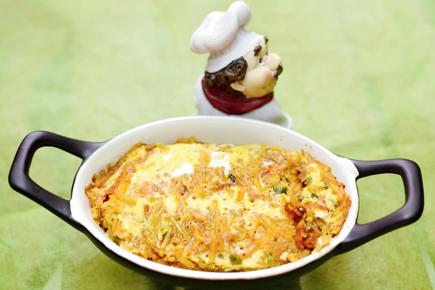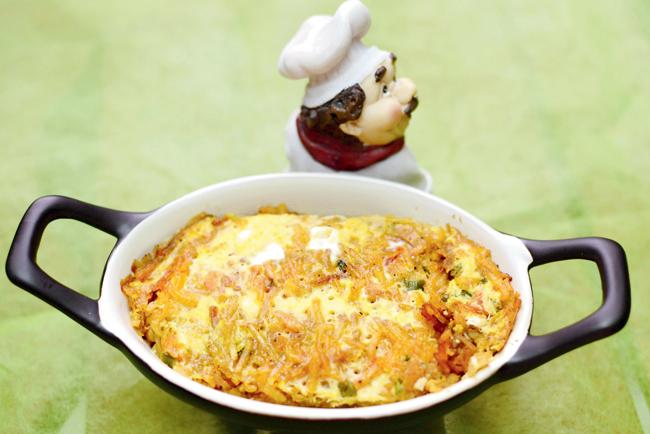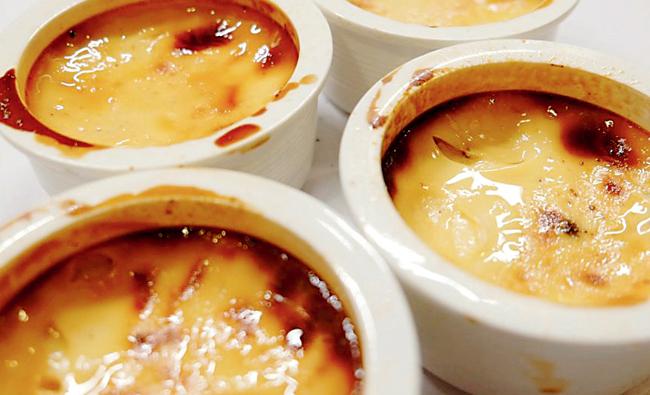There is no other ethnicity that can crack and cook an egg (eedu) as a Parsi does. From boiled to coating lady fingers with eggs, and even breaking the shell as an offering to evil forces, Kanika Sharma finds out why and how the Parsis fell in love with the eedu

Dolly Mummy's Sali Per Eedu
History says it all
In Persia, Parsis’ diet only consisted of pulses and meat as vegetables were hard to come by. Plus, most Parsis who were farmers ate roti/rice and meat. As the latter was not an option in India, chicken became the next option. Around 40 to 50 years ago, there were no commercial poultry farms. Thus, in order to have chicken, one would raise poultry, which meant chicken and eggs going hand in hand. While chickens have a high mortality rate, a large number of chickens also means a large number of eggs.
— Kurush Dalal, Katy’s Kitchen
ADVERTISEMENT

Eggs and us
As the Parsis had hobnobbed with the British, they have always been egg-friendly. Also, because Parsis have a rich background in baking, which was their traditional profession in Persia, eggs are integral to their cooking.
— Kurush Dalal
Memories galore
This recipe was my all-time favourite as a child, growing teenager, and now, in my early fifties. I cannot forget a day when mum (Perzen’s nani) had asked me, what would you like to take to college and I would quickly say — Sali Per Eedu. I got the secret from my younger brother, Rayomand, who visited me in New Zealand in 2009 while I was fighting for my life against Leukaemia. All the 21 days that he stayed with us and asked me what I would like to eat, I chose only this.”
— Shernaz Petigara, Perzen Patel’s mother, Bawi Bride
Whenever I would be sick, my mother would poach eggs in milk, something that I don’t see being done anymore. A traditional breakfast treat would be Ghee Gor Naiida (scrambled eggs, ghee and jaggery). The other delicacy that I don’t see any more is a semi-formed egg that is less albumen and more yolk. It’s got when you slaughter a hen. In Parsi weddings, usually, it would be laid out on the banana leaf and be served as a smaller dish in the common curry or like.
— Kurush Dalal
Taste factor
Eggs are a crucial component whenever we want to make a dish ‘vegetarian’. It helps us to jazz up our vegetables or leftovers. We don’t like many vegetables (except potato, which is in about all our dishes) and so, we normally break an egg on top to make the vegetables more appealing (or we add mutton). So, you have things like Tomato (we say ‘Tamota’) Per Eedu, Wafer Per Eedu and Bheeda Per Eedu.
— Perzen Patel
Dalal and Patel agree that eggs act as a binding ingredient for snacks like cutlets, kebabs and patties, and desserts like custard. Another use is for garnishing of varied pulaos. During the month of Bahman, most Parsis become vegetarian and egg is the sole substitute for protein.
Dolly Mummy's Sali Per Eedu
For preparation
>> 2 tbsp oil
>> 1 tbsp ginger garlic paste
>> 1 tsp turmeric powder
>> 2 tsp red chilli powder
>> 1 tsp garam masala
>> 1-2 green chillies, finely chopped
>> 1 cup coriander leaves, finely chopped
>> 1 tomato, finely chopped
>> 250 gm fine potato sticks (sali)
>> 2 eggs, whisked well
>> Salt to taste (less is recommended; potato sticks have enough
salt already)
Method
>> In a flat pan, heat up the oil. Saute the ginger garlic paste, green chillies, tomatoes, coriander and all spices.
>> Add the potato sticks into it and mix well.
>> Let all of the above be cooked on a slow fire for only then will it give away the lovely aroma.
>> Flatten the mixture across the cooking pan.
>> Gently sprinkle water over the mixture to create steam but not too much that the sali gets soggy.
>> Spread the whisked eggs across the pan and cover the pan with a lid allowing it to cook for 5-7 minutes. Slide the pan across the stove so that it cooks evenly.
>> Serve hot with rotlis or bread.
>> This makes for a good working lunch. If it’s planned for a party, break into bite-sized pieces and serve on rice crackers to add appeal.
Recipe extracted from the forthcoming e-book by Bawi Bride creator Perzen Patel, titled Eedu, that will release in the last week of August.
Email: perzen.patel@gmail.com
Lagan Nu Custard (servings 8 plus leftovers)
For preparation
>> 5 eggs
>> 1.5 litre milk
>> 1/3 tin condensed milk
>> 300 gm sugar
>> 1/2 tsp cardamom and nutmeg
>> 1 tsp vanilla essence
>> Handful of boiled and sliced almonds/pistachios (optional)

Method
>> Bring the milk to a boil in a large non-stick pan.
>> Once the milk has boiled, remove from the heat and stir in the condensed milk and sugar. Cook over a slow fire.
>> Keep stirring this for 15 minutes, until the sugar is melted and the milk sticky and ivory in colour. Remove from the gas and cool.
>> While this is happening, in a steel bowl beat the eggs, vanilla, nutmeg and cardamom, until frothy.
>> Stir this mixture into the cooled milk. If the milk is too hot, your egg is going to get scrambled so don’t rush this step! Once it’s all mixed, grease a large baking dish and pour the mixture in.
>> Put the dish in a pre-heated oven and bake until golden (atleast an hour on about 220 degrees
celsius). Garnish with the nuts and pop it back in the switched off oven.
>> Chill and serve — it tastes best the next day once the custard is set. Cut into small pieces and serve the family.
Call: 9820136511
Email: katyskitchenmumbai@gmail.com
Recipe courtesy Kurush Dalal, Katy's Kitchen
 Subscribe today by clicking the link and stay updated with the latest news!" Click here!
Subscribe today by clicking the link and stay updated with the latest news!" Click here!






